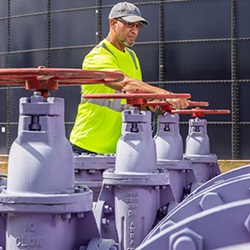Reclaimed water, also known as water reuse or water recycling, is water that has been used for human activities, and is then treated to a sufficient standard to be used again for certain human activities. These include agriculture, irrigation, and industrial processes – the largest consumers of water. With mounting global water scarcity, reuse is something we’ll be hearing a lot more about.
Though the technology exists to bring reclaimed water up to potable (drinking) water standards, it’s still uncommon, largely because of acceptance by the public and regulators. There’s one notable case in the U.S. – Orange County, California, which produces 70 million GPD of potable water that is then injected into water-supply aquifers or sent to infiltration ponds where it’s allowed to percolate into groundwater.
In fact, we already reuse water that has been used before, which the U.S. EPA defines as unplanned water reuse. A common example is a community that draws water from rivers, such as the Colorado and Mississippi Rivers, which has received treated wastewater discharge from communities upstream.
Planned Water Reuse
Planned water reuse, on the other hand, refers to water utility systems designed to recycle water before it’s reintroduced to the environment. Examples of planned reuse include:
- Agricultural irrigation
- Public space irrigation e.g., parks, roadways, sports fields
- Fire suppression
- Construction, cleaning, and dust control
- Industrial processes e.g., power plants, refineries, factories
- Indoor uses, such as toilet flushing
- Replenishment of lakes, reservoirs, and aquifers
 Reuse water is treated to meet a particular use, and is “fit-for-purpose”. For example, reclaimed water for agricultural irrigation needs to be of sufficient quality to prevent harm to plants and soils, maintain food safety, and protect the health of farm workers. In contrast, water used for cooling in an industrial process could be treated to a lower standard. Whichever is the case, reclaimed water is always kept separate from potable water, and is identifiable using purple-colored piping networks.
Reuse water is treated to meet a particular use, and is “fit-for-purpose”. For example, reclaimed water for agricultural irrigation needs to be of sufficient quality to prevent harm to plants and soils, maintain food safety, and protect the health of farm workers. In contrast, water used for cooling in an industrial process could be treated to a lower standard. Whichever is the case, reclaimed water is always kept separate from potable water, and is identifiable using purple-colored piping networks.
Water Reuse in the U.S. is Growing
Water reuse systems have been in place in the U.S. since the early 60s. Some states, most notably southern states such as Arizona, California, Colorado, Florida, Georgia, Virginia, and Texas, are actively promoting reuse. As of 2017, there were 763 water reuse projects in the U.S. as tracked by Bluefield Research, who estimated that $18 billion in projects were in development in 17 states. About half of the nation’s potable reuse systems have come online in the past 10 years, attesting to its growing popularity.
The U.S. EPA’s Safe Drinking Water Act and Clean Water Act provide a foundation for states to regulate and oversee water reuse as they see fit, and the EPA doesn’t require or restrict any type of water reuse.